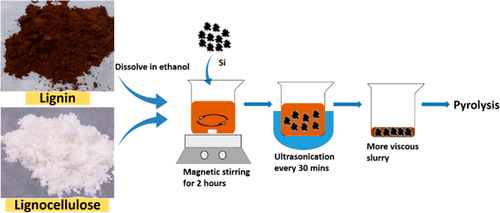当前位置:
X-MOL 学术
›
ACS Sustain. Chem. Eng.
›
论文详情
Our official English website, www.x-mol.net, welcomes your
feedback! (Note: you will need to create a separate account there.)
Silicon-Based Composite Negative Electrode Prepared from Recycled Silicon-Slicing Slurries and Lignin/Lignocellulose for Li-Ion Cells
ACS Sustainable Chemistry & Engineering ( IF 7.1 ) Pub Date : 2018-03-14 00:00:00 , DOI: 10.1021/acssuschemeng.7b03887 Che-Yu Chou,Jin-Rong Kuo,Shi-Chern Yen
ACS Sustainable Chemistry & Engineering ( IF 7.1 ) Pub Date : 2018-03-14 00:00:00 , DOI: 10.1021/acssuschemeng.7b03887 Che-Yu Chou,Jin-Rong Kuo,Shi-Chern Yen

|
A large amount of kerf loss silicon slurries has been produced in the photovoltaics industry by direct diamond-wire slicing. The high-purity silicon particles in the slurries are suitable for reutilization as anode materials for lithium-ion batteries. In this study silicon particles from the kerf loss of silicon ingot slicing, coupled with lignin or lignocellulose as carbon precursors, are employed to form carbon–silicon composite materials. A pyrolysis thermal treatment in the presence of argon was applied to carbonize the biomass on the silicon materials in order to increase the conductivity of silicon-based anodes. Due to the different carbonaceous precursors, the composites formed different structures. The lignin-silicon electrode with a carbon-coated structure delivered an initial charge capacity of up to 2286 mAh/g and retained 880 mAh/g after 51 cycles at 300 mA/g. On the other hand, the pyrolyzed lignocellulose formed an interconnected structure with silicon particles, providing extra space to accommodate Si volume variation. The composite electrode exhibited an outstanding cycle performance with a capacity retention of up to 83.4% after 51 cycles at 300 mA/g. It was found that the utilization of silicon slurries from industrial silicon kerf loss and of biomass resources as battery materials can be improved and applied in energy storage application.
中文翻译:

由再生硅切片浆料和木质素/木质纤维素制备锂离子电池的硅基复合负极
通过直接金刚石线切割,在光伏产业中已经产生了大量的切缝损失硅浆料。浆料中的高纯度硅颗粒适合用作锂离子电池的负极材料。在这项研究中,硅锭切片切缝损失中的硅颗粒与木质素或木质纤维素一起作为碳前体,被用于形成碳硅复合材料。为了增加硅基阳极的电导率,在氩气存在下进行了热解热处理以碳化硅材料上的生物质。由于碳质前体的不同,复合材料形成了不同的结构。具有碳涂层结构的木质素-硅电极提供了高达2286 mAh / g的初始充电容量,并在300 mA / g的51个循环后保持了880 mAh / g的初始电荷。另一方面,热解木质纤维素形成了与硅颗粒的互连结构,从而提供了额外的空间来容纳Si的体积变化。复合电极在300 mA / g的51次循环后表现出出色的循环性能,容量保持率高达83.4%。已经发现,可以改善由于工业硅切口损失而产生的硅泥的利用以及作为电池材料的生物质资源的利用,并将其应用于能量存储应用中。复合电极在300 mA / g的51次循环后表现出出色的循环性能,容量保持率高达83.4%。已经发现,可以改善由于工业硅切口损失而产生的硅泥的利用以及作为电池材料的生物质资源的利用,并将其应用于能量存储应用中。该复合电极在300 mA / g的51次循环后表现出出色的循环性能,容量保持率高达83.4%。已经发现,可以改善由于工业硅切口损失而产生的硅泥的利用以及作为电池材料的生物质资源的利用,并将其应用于能量存储应用中。
更新日期:2018-03-14
中文翻译:

由再生硅切片浆料和木质素/木质纤维素制备锂离子电池的硅基复合负极
通过直接金刚石线切割,在光伏产业中已经产生了大量的切缝损失硅浆料。浆料中的高纯度硅颗粒适合用作锂离子电池的负极材料。在这项研究中,硅锭切片切缝损失中的硅颗粒与木质素或木质纤维素一起作为碳前体,被用于形成碳硅复合材料。为了增加硅基阳极的电导率,在氩气存在下进行了热解热处理以碳化硅材料上的生物质。由于碳质前体的不同,复合材料形成了不同的结构。具有碳涂层结构的木质素-硅电极提供了高达2286 mAh / g的初始充电容量,并在300 mA / g的51个循环后保持了880 mAh / g的初始电荷。另一方面,热解木质纤维素形成了与硅颗粒的互连结构,从而提供了额外的空间来容纳Si的体积变化。复合电极在300 mA / g的51次循环后表现出出色的循环性能,容量保持率高达83.4%。已经发现,可以改善由于工业硅切口损失而产生的硅泥的利用以及作为电池材料的生物质资源的利用,并将其应用于能量存储应用中。复合电极在300 mA / g的51次循环后表现出出色的循环性能,容量保持率高达83.4%。已经发现,可以改善由于工业硅切口损失而产生的硅泥的利用以及作为电池材料的生物质资源的利用,并将其应用于能量存储应用中。该复合电极在300 mA / g的51次循环后表现出出色的循环性能,容量保持率高达83.4%。已经发现,可以改善由于工业硅切口损失而产生的硅泥的利用以及作为电池材料的生物质资源的利用,并将其应用于能量存储应用中。











































 京公网安备 11010802027423号
京公网安备 11010802027423号